Recently, I have been spending a lot of time in various Facebook groups that I am a member of. One such group that always has really interesting content, and a group that I have found several “new to me designers” in, is Wargamers. I have been reading several of Ty Bomba’s posts and looking at his list of upcoming titles, one jumped out to me as particularly interesting called Triumph of the Will: Nazi Germany vs. Imperial Japan, 1948. Not having the good fortune of having talked with Ty previously, but having read lots of his very interesting “Work Diary Entry” posts as he calls them, I reached out to him and he graciously accepted my invite for an interview.
Grant: Ty, first off, tell us a little about yourself.
Ty: I’ve worked as a full-time professional in conflict simulation design and development for the past 29 years, and I worked semi-professionally in that same field for the 20 years prior to that. In total, I have almost half a century’s experience in historical background research, writing, design, development and application of articles and simulations for managerial, military, educational, historiographic and entertainment uses.
In 2011, I was promoted to the position of senior editor at Strategy & Tactics Press, where I oversaw the publication of three internationally distributed magazines: World at War (WW2), Strategy & Tactics and Modern War. I left that position at the end of 2014 and returned to freelance editing, writing and designing.
Earlier I was co-founder, CEO and chief simulation designer and developer for XTR Corporation, a company that for a dozen years (1989-2001) was dedicated to the research, creation and production of wargames. All totaled, I’ve written over 100 published articles and reports on the topics of military history, simulation design and development techniques.
From 1976 to 1980, and again from 1984 to 1988, I held a top secret codeword security clearance as a certified Arabic and Russian linguist, intercept operator and analyst, for the US Air Force, US Army and National Security Agency. At times my duties put me in direct communication with the White House, and I prepared and presented intelligence briefings for general-grade officers. I also performed real-time interception, decryption and reporting of hostile-nation communications, specializing in the militaries of the USSR, Libya and other North African nations.
Grant: So, you kind of know what you are talking about in regards to consim. What is your current day job?
Ty: This is my day job (and my night job).
Grant: How did you get into board game design?
Ty: I just grew into it as, what seemed to me at least, a natural extension of wargame play. First I designed new scenarios for existing games, and it just kept expanding from there.
Grant: What games do you play when you aren’t designing?
Ty: I enjoy taking part in the playtesting of the projects of other designers with whom I’m friends. I always get my best ideas from other people.
Grant: What do you love most about design?
Ty: There’s nothing I dislike about it except it’s underpaid as a profession.
Grant: What is your greatest challenge in design?
Ty: The fact there aren’t enough hours in a day, or days in a week, or weeks in a year. I’m told this is a common problem.
Grant: What games or designers have influenced your designs?
Ty: The list is too long. I always approach the work of others with the idea of learning something from them. Even the few who’ve only demonstrated to me what I don’t want to do in my own work have helped in that way.
Grant: What is your design philosophy?
Ty: If a game can’t be played to a satisfactory ending – no matter what else may have gone into it by way of clever ideas, superb physical production, etc. – it’s not worth the effort.
Grant: How did you come to be connected with Compass Games?
Ty: I’d been aware of Compass Games for years, since they bought the rights to some of our old XTR/Command games. So, as soon as I began looking around for work after leaving the senior editor slot at S&T Press, it was a no-brainer to e-mail them. There production values are top-notch.
Grant: What was your impetus for designing an alternate history war game?
Ty: I know some in the hobby don’t get this, but: they’re ALL alternative history games. Some just more so than others. It’s a continuum, not a dichotomy.
“I know some in the hobby don’t get this, but: they’re ALL alternative history games. Some just more so than others. It’s a continuum, not a dichotomy.”
Grant: What specifically is challenging about doing an alternate history game?
Ty: The same things that are challenging about straight-up historical titles, no more and no less. In fact, in regard to play balancing via order of battle tuning and victory conditions, they’re often easier in that you don’t have to measure them against an actual outcome.
Grant: What is Triumph of the Will about?
Ty: It’s a global mini-monster game covering the whole of an alternative history World War III that’s fought out between Nazi Germany and Imperial Japan starting in 1948. The idea is they won World War II and are squaring off against each other in a final showdown for planetary control.

Grant: What does the title mean in relation to the game and its subject?
Ty: At the personal level, I’ve wanted to do another global-map game ever since finishing  the second edition of Tomorrow the World about a quarter-century ago. This time, though, I wanted to do it in a framework that could be played to the end in one sitting. So this game’s appearance represents the triumph of my will on that score. It’s important for strategists who want to have any real claim to that sobriquet to experience strategy at the global level – it’s ultimate level. More thematically, of course, the title also ties dramatically into Hitler’s idea of the final “war of the continents,” as he used to describe it, and which he foresaw as effectively bringing history to a conclusion via the conquest of the whole planet by the Germans – and which he imagined as coming to pass via the ultimate triumph of his will.
the second edition of Tomorrow the World about a quarter-century ago. This time, though, I wanted to do it in a framework that could be played to the end in one sitting. So this game’s appearance represents the triumph of my will on that score. It’s important for strategists who want to have any real claim to that sobriquet to experience strategy at the global level – it’s ultimate level. More thematically, of course, the title also ties dramatically into Hitler’s idea of the final “war of the continents,” as he used to describe it, and which he foresaw as effectively bringing history to a conclusion via the conquest of the whole planet by the Germans – and which he imagined as coming to pass via the ultimate triumph of his will.
Grant: Is it realistic that Germany and Japan could have won World War II and what needed to happen differently to allow their victory?
Ty: The only way they could’ve won World War II – within our own unchanged timeline up to 1939 – would’ve been had they brought in the Soviet Union on their side, thereby changing the Anti-Comintern Tripartite Pact into a Quadripartite Totalitarian Anti-Democratic Pact. Hitler forswore that option when he refused to award Bulgaria to Stalin late in 1940.
Grant: What is the scale of the game?
Ty: It’s an area movement game using a “modified azimuthal” map. That means, for example, one inch at the equator doesn’t equal one inch at the poles, etc. The entire globe is portrayed on two 34″ x 22” maps that join together across their long sides for a playing area of 34″ x 44″.

Grant: Who is the map artist?
Ty: I’ve attached a copy of the playing area here in a jpeg, but it’s minus the charts and tables that run across the complete map’s extreme north and south edges. The artists are Wojciech and Rafal Zalewski, a father-son team out of Warsaw, where they together publish their own Polish-language magazine-with-wargame: Taktika i Strategija.
Grant: The design assumes Italy is an ally of Germany at the outset. What happens if they defect to the Japanese?
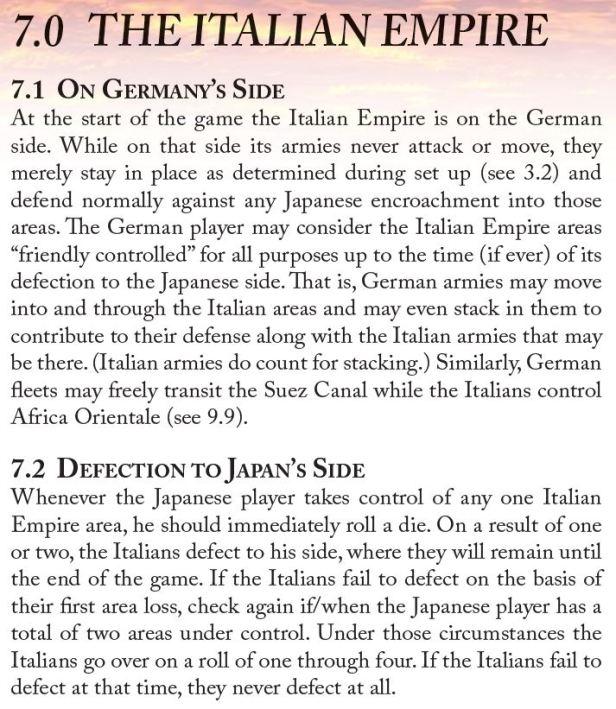
Ty: I essentially programmed Italy into the same grand-strategic role it had in World War II: a weak authoritarian state unable to handle for long the stresses involved in an all out war. So they behave the same here as they did historically when things get tough: they switch sides. There used to be an old saying the House of Savoy (the royal family of Italy) never finished a war on the same side as it began it unless it was because they had switched sides more than once during it.
Grant: The counters look to be minimalist, but simple is a good thing. How do you play a grand scale strategy game with such little written information on the counters?
Ty: All the information you need to move and fight with them is on the counters. More information than that makes for less playability, not more.
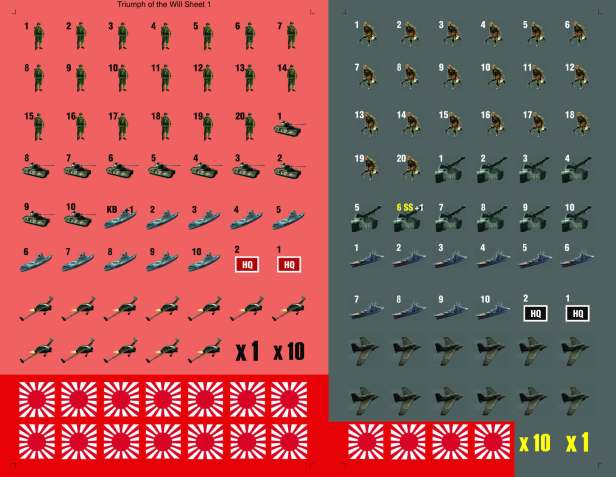
Grant: Why did you decide to go this route?
Ty: If your goal is to cover the entirety of a global war, a certain amount of abstraction is necessary or all playability will be lost.
Grant: How do players determine their initial OoBs?
Ty: They purchase their units from their nation’s overall Orders of Battle prior to setting up. Those OoB are modeled from the regular field armies both sides had during World War II. I left out the ad hoc emergency creations of the latter part of that war because those emergencies never happened here for the Axis. Similarly, both empires are now already at such overstretch that creating more army, fleet and air force formations would be impossible in the practical sense. On the naval side, the assumption is the Germans got done with their Z-Plan fleet expansion program.
Grant: What flexibility does this allow and how does it affect strategy?
Ty: Both sides can lean a certain amount toward emphasizing ground or air or naval forces, or they can go with a fully balanced approach.
Grant: Variable control is given for four areas. What areas are they? How do you determine control? Why did you include this in the design?
Ty: Mexico, Panama, the Northern Andes and the Southern Andes – essentially a line running along Central and South America, are variably controlled (two and two) at the start of set up. The ‘historic’ rationalization for choosing that area was because I reckoned it was likely the last geostrategic zone where the advancing forces of the two empires would’ve come together as they closed out World War II. In practice, it allows for more replay value by aborting any perfect set up that would always apply in a game with totally fixed boundaries.
Grant: What are the victory conditions?
Ty: You win by taking the other side’s capital province. Alternatively, both the Germans and Japanese lose if they let the UN rebellions get out of hand, or if they allow the climate to descend into “nuclear winter” by their over use of atomic weapons.
Grant: How does this effect strategy for both sides?
Ty: You can either go directly – blitzkrieg and banzai like – as fast and as directly as possible for the other guy’s capital, or you can go more conservatively, step by step, and try to get there more slowly but, at the same time, more securely. Beyond that choice, you also have to play so as to avoid losing even as you’re trying to win. There are, operatively speaking, more ways to lose than there are to win.
Grant: Which are easier to obtain and for which side?
Ty: I don’t believe there’s a set answer to that question. It will depend on the relative skill match up between any two opponents.
Grant: What is the Turn Sequence?
Ty: Here is the Sequence of Play in an outline form:
Sequence of Play Outline
- Production Phase
- Air Superiority Phase
- Alternating Actions Phase
- Nuclear Winter Phase
- Rebellion Phase
- Recovery Phase
Grant: Rather than discussing each phase, I will try to ask you about some of the phases that look most interesting to me. How does the Air Superiority phase work and what does it represent?
Ty: If you get air superiority, it can lead to a battlefield advantage of a die roll modifier. I figure both these empires’ militaries stayed married to the idea of tactical air forces. Since they won World War II, they would’ve had no motivation to go strategic in that way prior to the advent of the potentially war-winning a-bomb.
Grant: Nuclear Winter sounds pretty interesting. How does this come about and what effect on the game does it have?
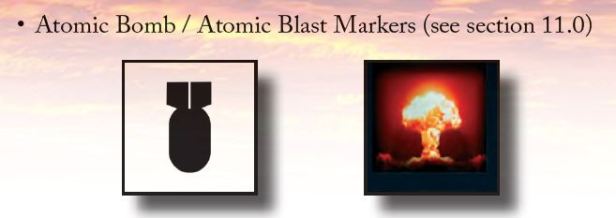
Ty: It comes about like this, and it’s a game ender.
During every turn’s Nuclear Winter Phase, once the total number of atomic detonations has gone above 12, the player who, during that turn’s just ended Alternating Actions Phase set off the last one of those detonations, openly rolls a die. Then both players reference that result to jointly consult the Nuclear Winter Table printed below and on the mapsheet.
| Total Detonations | Die Roll to Start Winter |
| 1 through 12 | No Chance of Winter |
| 13 through 18 | 1 |
| 19 through 24 | 1 or 2 |
| 25 through 30 | 1 through 3 |
| 31 through 36 | 1 through 4 |
| 37 or More | 1 through 5 |
If the roll indicates nuclear winter has begun, the game ends and the player whose last atomic attack was the most recent one has lost the game. If nuclear winter hasn’t begun, play continues. The total number of detonations noted on the track on the mapsheet is never wiped clean or reduced in any amount; its total stays in place until (if) it’s increase again during the next AAP. Also note that dud non-detonations (see section 11.0) don’t raise the total, only successful blasts.
Grant: What happens in the Rebellion Phase? How does Rebellion spread?
Ty: From the rules: During every turn’s Rebellion Phases, both players cooperate to identify every land area on the map (mainland and island) that doesn’t have at least one German, Japanese or Italian army in it (but excluding both sides’ capital areas). As each area like that is identified, the player who doesn’t own it rolls a die. On a result of six or more, a rebellion (under the auspices of the renegade “United Nations” resistance organization) has broken out in that area. Add one to the rolled result for every area adjacent to the area being rolled for that already has one or more rebellion markers in it. (For example, if you were rolling for Brasil, and there was already a rebellion underway in Patagonia and the Northern Andes, you’d add two to whatever result you rolled.) The same player then immediately rolls a second die and places that many revolt markers in the newly revolted area (one through six).
Grant: How does movement function? How does stacking effect movement?
Ty: From the rules: Moving one, some or all of your units (a “force”) from one area into another is one of the choices available for each of your actions throughout every AAP. It’s the method by which armies and fleets move from an area to an adjacent area across the map. Moves may potentially be of any length. An army or fleet unit or stack move consists of you openly selecting one of your side’s forces in any one area on the map and then moving it into and through potentially any number of adjacent friendly controlled areas to your desired final location for it. There’s no arbitrary limit on the number of move actions you may decide to conduct over the course of every turn’s AAP. As long as you observe the stacking limit, it doesn’t effect movement.
Grant: Why no Fog of War aspect regarding troop levels?
Ty: The units are whole armies, air forces and fleets; so there’s just not much room for ‘fog’ in regard to the usual hide-them-in-the-stack rules for games of lesser scales. The ‘fog’ here comes from the fact your opponent has the whole world across which to plan and execute his strategy, which makes for a lot of potential fog at that higher level.
Grant: How are Elite Armies and Fleets different from regular units?

Ty: You get a combat die roll modifier for Sixth SS Panzer Army on the German side and for the Kido Butai fleet on the Japanese side.
Grant: I see you have included rules for land bridges, blocked areas, canals as well as Gibraltar. How does geography play a part in Wargame design?
Ty: I modeled the geographic restrictions and advantage onto the map that would effect the deployment of whole armies, air forces and fleets across the globe at this level of technology (mid-20th century).
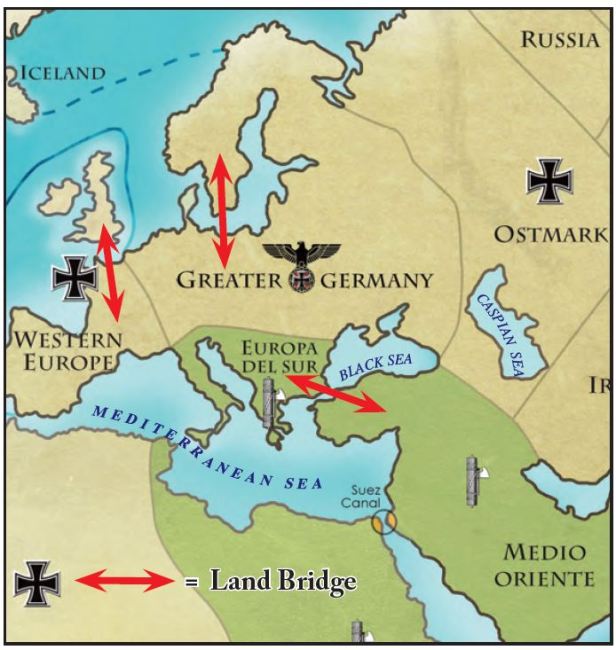
Grant: How does combat work? What DRM did you include?
Ty: You ‘shoot’ at each other – via compared die rolls – as in games like Risk and A House Divided. There are DRM for elite status and air superiority.
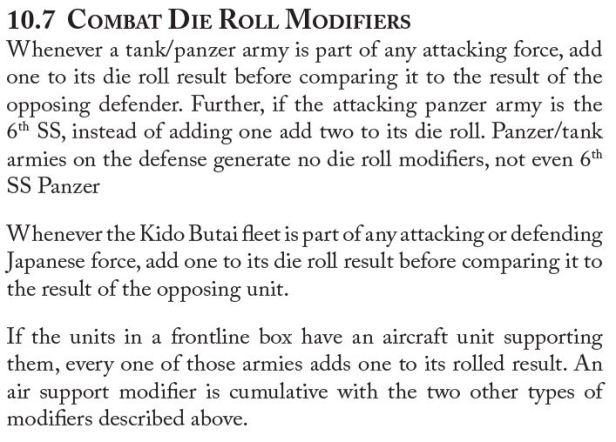
Grant: What is Momentum Combat and how should it be properly used?
Ty: It allows a victorious force to attack again (once) immediately after taking control of the area into which it just attacked and won. It allows for exploitation at the strategic level and rewards the player who keeps defensive reserves on hand. I don’t think there’s any set rule as to when it should be properly used: use it when it furthers your larger plan to do so.

Grant: What about Atomic attacks?
Ty: Here’s the resolution table, it can be pretty deadly, but you’ve got to keep in mind the threat of nuclear winter or you’ll blast yourself into defeat.
Atomic Attack Table
| Die Roll | Result |
| 1-4 | The targeted unit is eliminated. |
| 5 | The targeted unit is disrupted. If the targeted unit was already disrupted there’s no further effect, but this counts as a detonation and a blast marker is placed. |
| 6 | The bomb failed to detonate. No blast marker is placed. |
Grant: Why was this included in the design?
Ty: Nothing in the rules of the game forces either player to use atomic weapons. In fact, the nuclear winter victory condition mitigates against it. At the same time, though, if such a nightmare scenario as we’re modeling here had indeed taken place, do you think for a moment either of these regimes wouldn’t have reached for WMD? So the rule is there for ‘historical realism.’ So if you have a moral objection to such a concept as being part of your play, you can agree to leave it out.
Grant: What are some strategies that need to be focused on for each side?
Ty: Phew! The best summary I could give would be: keep your powder dry and watch your topknot. This is a global game; there is no strategic approach that isn’t potentially available.
“Phew! The best summary I could give would be: keep your powder dry and watch your topknot. This is a global game; there is no strategic approach that isn’t potentially available.”
Grant: How long does a full game typically last?
Ty: Depending on how nuke-happy the players become, the longest matches will take about six hours.
Grant: Are there smaller scenarios? Why or why not?
Ty: There’s one scenario: World War III fought across the planet. What would be the point of anything less?
Grant: Good point! What has changed through the playtest process? Please give specific examples.
Ty: Nothing – I carried this game in my head, assembling it bit by bit over the past 25 years or so. When I finally got the chance to do it, it rushed from my mind and onto the table like a spilled bucket of molten steel.
Grant: What are you most proud of in the design?
Ty: That I’ve devised a game of global strategy that can be played to conclusion in one sitting.
Grant: What experience do you desire for players to have?
Ty: Fun – gobs of fun – in a dark humor kind of way, while also experiencing the art and craft of strategy played out across a global stage.
Grant: What is the timeline for the game? Expected MSRP?
Ty: I’m told it will be out sometime this summer (2017). I don’t know what the MSRP will be. That decision will be made at an echelon above mine.
Thank you for your time Ty. I appreciate you taking a break from your busy design schedule to work with me on this interview. If you are interested in Triumph of the Will, you can check out the Pre-Order page on Compass Games at the following link: https://www.compassgames.com/preorders/triumph-of-the-will.html
-Grant


Can’t wait for this game. Prepaid for this as soon as it hit Compass preorder page.
LikeLiked by 1 person
I also think it looks good. Simple yet enough there to keep it interesting while not requiring a fortnight to play. Thanks for reading.
LikeLike
Kind of disappointing to see someone like Ty Bomba so wrongheaded on Germany and WWII.
There never, ever, ever, ever could have been any kind of solid alliance between Germany and the Soviet Union. The entire point of Hitler starting WWII was to seize the food-producing areas of the Soviet Union. That’s it. That was the whole reason of WWII. Germany had too many people and not enough land. The land was giving out and Germany wouldn’t be able to feed itself. On that day, Germany would have to become dependent on food imports, and would have to kneel before the international bankers and become yet another slave.
The only way to avoid this was to conquer the rich food producing land lying to Germany’s east. This is all in Mein Kampf. It had nothing to do with awarding Bulgaria. It was set in stone in the 1920s. The Ribbentrop-Molotov pact was a thieves’ bargain which both sides knew would be broken at some point. Hitler also considered the Bolsheviks who took over Russia as a dagger aimed at Europe’s heart and he thought he was doing the world a favor taking them out.
LikeLike
I think his comment is dead on. Germany lost because of a two front War. Also it’s his opinion.
LikeLiked by 1 person
I think you said it yourself: “The Ribbentrop-Molotov pact was a thieves’ bargain which both sides knew would be broken at some point.” This statement and Ty Bomba’s statement are not logically inconsistent. This game postulates that Japan, Germany, and Italy won World War II; the Soviet Union is no more when this game begins. The parties could have kept the thieves’ bargain long enough to collectively destroy the democratic Allies and then Japan, Germany, and Italy could have turned on Stalin. Not likely, but possible.
LikeLike